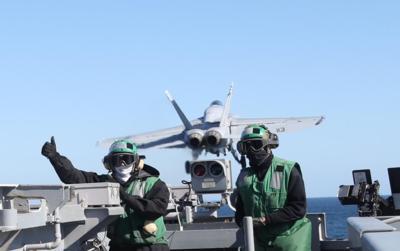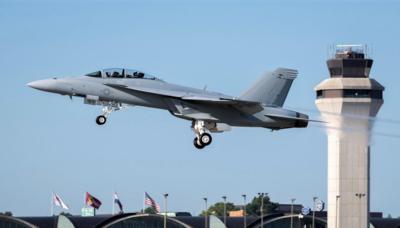Fri, Dec 17, 2021
Precision Landing Mode Automates, Simplifies High-Precision Flight in Refueling and Landing
The Navy's infamously difficult carrier landings, long the bane of Naval aviators in their early training days, have seen the first major equipment update in years, with flight control tech that leverages automation, connectivity, and precise aircraft control.

Precision Landing Mode (PLM) is the newest capability from the Navy's PMA-265 Program office, a system that, according to the announcement: "drastically reduces the number of inputs a pilot must make on final approach to the carrier. With its optimized control laws and tailored displays, PLM eases pilot workload and makes landing much safer and simpler. Additionally, it improves overall recovery time, reduces tanker requirements and streamlines training requirements."
The latest version of the upgrades were delivered to the fleet in October 2021, improving on previous iterations of the system that disabled the tech under many failure conditions. Now, PLM can be engaged during engine-out approaches, or even with a fire on board the aircraft. “During a single-engine approach, PLM helps to provide the pilot with a platform that feels very similar to a dual-engine approach, maximizing climb performance and helping the jet stay in balanced flight,” said Commander Luke Davis. “PLM provides the pilot with a reliable, stable platform to safely recover at the ship or airfield.”

The system is now baked into each pilot's training from the start, being included for new pilots of the F/A-18E/F Super Hornet or it's Growler sister aircraft. Air wings have added it to their carrier qualification deployments, noting that in some cases their training requirements have gone down by up to 50%. Old salts in the ready room may decry the timeless pattern of technology replacing hard-earned but worthwhile pilot skills once again, but like many other newfangled adjuncts, the romance of doing everything manually is seldom found during an engine out, hard IFR approach.
More News
Pilot Also Reported That Due To A Fuel Leak, The Auxiliary Fuel Tanks Were Not Used On June 4, 2025, at 13:41 eastern daylight time, a Piper PA-23, N2109P, was substantially damage>[...]
Have A Story That NEEDS To Be Featured On Aero-News? Here’s How To Submit A Story To Our Team Some of the greatest new stories ANN has ever covered have been submitted by our>[...]
From 2023 (YouTube Edition): Reflections on War’s Collective Lessons and Cyclical Nature The exigencies of war ought be colorblind. Inane social-constructs the likes of racis>[...]
Aero Linx: Colorado Pilots Association (CPA) Colorado Pilots Association was incorporated as a Colorado Nonprofit Corporation in 1972. It is a statewide organization with over 700 >[...]
High Speed Taxiway A long radius taxiway designed and provided with lighting or marking to define the path of aircraft, traveling at high speed (up to 60 knots), from the runway ce>[...]
 NTSB Prelim: Piper PA-23
NTSB Prelim: Piper PA-23 ANN FAQ: Submit a News Story!
ANN FAQ: Submit a News Story! Classic Aero-TV: One Mans Vietnam
Classic Aero-TV: One Mans Vietnam ANN's Daily Aero-Linx (07.03.25)
ANN's Daily Aero-Linx (07.03.25) ANN's Daily Aero-Term (07.03.25): High Speed Taxiway
ANN's Daily Aero-Term (07.03.25): High Speed Taxiway




